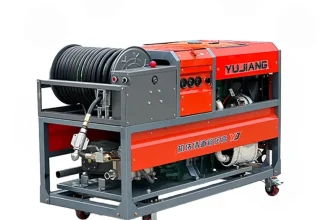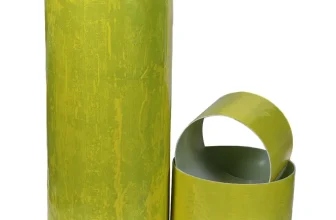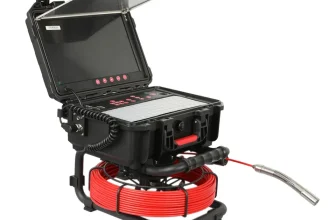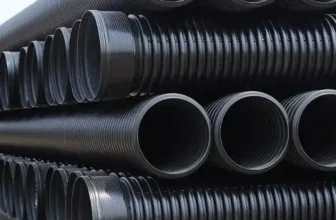Traditional sewer line replacement is a method that has been used for
generations to replace old, damaged, or blocked sewer lines. This
process generally involves digging a trench or wide hole over the length
of the pipe to manually expose and remove the existing line. Once the
old line is out, a new one is placed in the dug up trench, and then it’s
covered back up. While this process is often effective in replacing the
pipe, it comes with a significant amount of disruption. This is
primarily because it not only requires extensive digging and physical
labor but also potentially damaging landscaping, hardscaping, or any
other structures sitting atop the sewer lines. It’s a time-consuming and
labor-intensive process, often resulting in additional costs related to
restoring the area post-replacement.
Introduction
to Trenchless Sewer Line Replacement
Trenchless Sewer Line Replacement is an innovative solution to the
age-old problem of repairing or replacing defective or obsolete sewer
lines. Traditionally, replacing sewer lines involved disruptive and
labor-intensive excavation work, which not only damaged the landscape
but also incurred high costs in terms of time, money, and effort.
However, with the advent of trenchless technology, it is now possible to
repair or replace sewer lines with minimal digging and disruption. This
method, as the name implies, doesn’t require trenches to be dug across
your property. This not only saves your landscaping from ruin but also
saves the expense and inconvenience of surface restoration post the
sewer line works. In the next sections, we will delve deeper into what
trenchless sewer line replacement entails, how it works, its benefits,
and its drawbacks.
What is Trenchless
Sewer Line Replacement?
Detailed definition
Trenchless Sewer Line Replacement, as the name implies, is an
innovative method of repairing or replacing damaged sewer lines without
the need for extensive excavation. It involves creating either small
access holes where the damaged pipe starts and ends, or no holes at all,
hence the term ‘trenchless.’ Through these holes, new or repaired pipes
are installed or existing pipelines are rehabilitated.
These new pipes, often made up of specialized materials like epoxy
resins or a type of plastic called ‘cured-in-place pipes’, are either
pulled or blown into the old pipes to form a pipe within a pipe, or the
old pipes are burst and pushed outward, while the new pipe takes its
place. This technology allows for the seamless repair or replacement of
sewer lines with minimal disruption to the property above.
In essence, Trenchless Sewer Line Replacement offers a less invasive,
more efficient, and often more cost-effective solution to the
traditional methods of sewer repair and replacement, ensuring a longer
lifespan for your sewer system without the added mess of digging up your
yard or driveway.
Brief history and
development
Trenchless sewer line replacement, often referred to as “no-dig”
technology, has a relatively recent history. Its development began in
the late 1970s and early 1980s as a response to the growing need for a
more efficient and less destructive method of maintaining and repairing
sewer lines.
It was in the United Kingdom where the groundwork for trenchless
technology was laid. A man named Eric Wood developed an innovative
method of relining pipes with a polyester resin, thereby creating a
‘pipe within a pipe.’ His company, Insituform, patented the technology
in 1977, signalling the birth of modern trenchless technology.
Over the years, the technology has been refined and diversified. In
1994, the International Society for Trenchless Technology was
established to promote its use and further its development. The Society
has been instrumental in encouraging education, research, and technical
excellence in the industry.
The 1990s also saw the introduction of pipe bursting, a trenchless
method that involves breaking and expanding the existing pipe while
pulling a new one into place. This added a more versatile tool to the
trenchless tech toolbox, extending its usability to instances where
existing pipes were severely damaged and couldn’t be relined.
Today, trenchless technology is widely recognized and implemented
across the globe. Engineers and contractors consider it a go-to solution
for sewer line repairs, due to the method’s combination of efficiency,
reduced environmental impact, and cost-effectiveness compared to
traditional methods.
How does
Trenchless Sewer Line Replacement work?
Explanation of the process
Trenchless sewer line replacement is essentially a method of
replacing old pipe lines without digging a full-length trench. The
process generally comprises of three key steps: examination, cleaning
and the actual replacement.
First, a careful examination and evaluation with the use of
high-resolution cameras are performed. These cameras are snaked through
the existing sewer lines to get a comprehensive understanding of the
degree of damage and obstruction. This not only helps in diagnosing the
problem but also illustrates the layout of the line, which is critical
for the next processes.
Secondly, cleaning is undertaken. Any debris, blockages or roots that
might be causing problems are cleared out using hydro-jetting or
mechanical rodding. In certain severe cases, the provider might have to
use stronger cleaning methods before going ahead with the repair or
replacement.
Lastly, the existing pipe is either broken or relined with the help
of the two major techniques: Pipe Bursting or Pipe Lining.
In Pipe Bursting, a bursting head, attached with a new plastic pipe,
is pulled through the old pipe. The bursting head fractures the old pipe
and pushes the sections into the surrounding soil, while the new pipe
takes its spot.
In Pipe Lining, an epoxy-saturated liner, also known as
Cured-In-Place Pipe (CIPP), is pulled or blown into the damaged pipe and
then left to cure. The curing can either be done with the help of hot
water, steam or by emitting UV light. After this acts harden, a new
solid pipe within the old one is created.
At the end of the process, another camera inspection is performed to
ensure that the job was done correctly. This is the general method of
trenchless sewer line replacement. There might be slight variations in
the process depending on the specific condition of the sewer line, and
the techniques the service provider uses.
Different techniques used
Pipe Bursting
Pipe bursting is a trenchless method of replacing buried pipelines,
such as sewer, water, or natural gas pipes, without the need for a
traditional construction trench. This method is used when existing pipe
systems have deteriorated or are insufficient, and there’s a need to
restore fluid flow with a more functional and durable piping system.
The technique involves the use of a machine that effectively ‘bursts’
the old, damaged pipe and simultaneously places a new pipe in its place.
The process begins by digging small access holes where the damaged pipe
starts and ends. A high-powered machine, also known as a pipe bursting
head, is then lowered into one of the access holes.
This bursting head is usually cone-shaped and larger in diameter than
the old pipe. It is affixed to a new pipe and pulled with high force
through the existing pipeline. As it is pulled, it shatters the old pipe
into pieces – hence the term ‘pipe bursting’. Following closely behind
the bursting head, the new pipe is pulled into position. When the
operation is completed, the old shards are left alone and gradually
become part of the surrounding soil, posing no harm to the
environment.
Pipe bursting offers an impressive level of precision. It gives
operators the ability to accurately follow the path of the existing
pipe, ensuring a consistent grade and reducing the risk of future
issues. While the process might sound quite intense, it is perfectly
controlled, with the team at the surface managing the operation and
ensuring it is executed smoothly and quickly.
This method is particularly useful for situations where the original
pipe is severely damaged or deteriorated, where simple relining might
not be enough. Pipe bursting has revolutionized the sewer line
replacement process, providing a less disruptive and more efficient
technique for homeowners and communities alike.
Pipe Lining
Pipe lining is one of the key techniques used in trenchless sewer
line replacement. Also known as Cured-In-Place Pipelining (CIPP), this
method is utilized when the existing sewer pipes have gaps, cracks, or
minor damage, but their structural integrity is still intact.
The process begins by thoroughly cleaning the pipe using
hydro-jetting to remove any accumulated debris. This prepares the pipe
for the lining process and ensures a sturdy and smooth surface for
adhesion. Once the pipe is clean, a flexible, resin-saturated tube made
of flexible material like felt or fiberglass is inserted into the old
pipe.
The tube, also referred to as a liner, is then inflated using
pressurized water or air, which allows it to take the shape of the
existing pipe. As the resin hardens, it forms a new pipe within the old
one that is leak-resistant and capable of withstanding typical sewer
conditions.
This pipe within a pipe method does not require the old pipe to be
removed. Therefore, it is highly effective in preserving landscaping,
driveways, and other structures that might otherwise be affected by
traditional replacement methods.
Pipe lining is typically suitable for pipes that are up to 200 meters
in length and 75-200mm in diameter. However, it’s also scalable and
flexible, making it an excellent option for pipes lying beneath
significant obstacles like buildings or highway infrastructure. In most
cases, the entire process can be completed within a day, thereby
reducing labor costs and minimizing disruption to the property and its
occupants.
Pros and
Cons of Trenchless Sewer Line Replacement
Pros
Less intrusive
Trenchless sewer line replacement stands out in its minimal
invasiveness compared to traditional methods. Traditional sewer line
replacement necessitates significant digging—resulting in numerous
trenches in your yard, often ruining landscaping in the process. On the
other hand, trenchless sewer line replacements involve creating only one
or two small access holes, eliminating the need for extensive
excavation. Consequently, your yard, driveway, and flooring remain
mostly undisturbed, which is a significant advantage for homeowners who
want to maintain the aesthetic value of their properties. The reduction
in property disruption also means you won’t have to budget for
additional restorative works after the sewer line replacement. This
aspect of being less intrusive not only preserves the beauty of your
property but also contributes to the overall convenience and simplicity
of sewer repairs.
Time and cost-effective
Trenchless sewer line replacement proves to be time and
cost-effective in several ways. Firstly, the time required to complete
the process is significantly less than the traditional method.
Traditional methods require excavation of the yard or driveway, which
can take days or even weeks depending on the complexity of the project.
However, trenchless sewer line replacement can usually be completed in a
day, making it substantially quicker.
Beyond the speed of implementation, the method also reduces the
financial burden in multiple ways. There won’t be extra costs associated
with restoring your landscape post-replacement as there’s no need for
disruptive digging or trenching. This can equate to significant savings,
particularly for businesses that may have to close during repair or
homeowners who would need to renovate their yard after the work.
The durability of the replacement is another beneficial aspect to
factor in. Trenchless repair or replacement technologies use seamless
Polyethylene pipe, known for its durability and longevity. It is highly
resistant to cracking, root intrusion, and corrosion, meaning fewer
future replacements and repairs, which saves more in the long run. Thus,
while the initial cost might be slightly higher, its long-term
cost-effectiveness is definitely significant when considering the
potential to evade future repair fees and landscape restoration
expenses.
Environmentally friendly
Trenchless sewer line replacement is exceptionally environmentally
friendly. As traditional methods often involve extensive digging and
displacement of soil, it can disrupt the natural habitat of the
surrounding ecosystem and cause significant harm to plant life. In
contrast, trenchless methods minimize the need for excavation, leaving
much of the terrain undisturbed and preserving the integrity of local
flora and fauna. Moreover, since trenchless technology uses existing
lines, it reduces the amount of waste materials discarded in landfills.
This method further contributes to environmental conservation through
reduced emissions, as fewer heavy machines are required to operate
on-site for prolonged periods.
Cons
Not always possible
Trenchless sewer line replacement, while a game-changer in sewer line
servicing, unfortunately falls short in certain situations and is not
always possible. For instance, severely damaged or collapsed pipes may
not be eligible for trenchless repair methods. The technology relies
heavily on the existing sewer line infrastructure as a guide for repairs
and upgrades, meaning it cannot work if the existing structure is beyond
repair or non-existent. Moreover, despite its advanced capabilities,
specific issues such as joint misalignments, bellies in the line, or
buildups of massive in-ground root systems could restrict trenchless
methods, requiring the need for more traditional approaches. This
limitation needs to be considered when deciding on the best course of
action for sewer line replacement.
Initial costs may be higher
Although trenchless sewer line replacement provides numerous
advantages, one of its major drawbacks is the initial costs which can
sometimes be higher than traditional techniques. This high upfront cost
primarily results from the specialized equipment and advanced technology
utilized in the process. Moreover, the expertise required for trenchless
repairs also contributes to the cost. Contractors with knowledge and
experience in this sector might charge more for their services compared
to traditional repairmen. Nevertheless, when weighing this against the
possible destruction and restoration costs associated with traditional
methods, trenchless sewer line replacement often ends up being more
cost-effective in the long run. Not to mention, the durability also
plays a role in offsetting the initial costs, making it a worthwhile
investment for the foreseeable future.
Trenchless
Sewer Line Replacement Vs Traditional Methods
Comparison of techniques
The assessable contrast between trenchless sewer line replacement and
traditional methods lies in their implementation techniques. Traditional
sewer line repair oftentimes requires extensive digging, causing
landscape disruption and overall chaos. This approach involves creating
trenches or ditches to get access to the affected pipes, hence creating
higher chances of property destruction.
On the other hand, Trenchless sewer line replacement employs
sophisticated techniques that dramatically reduce the need for said
disruption. The process is done underground requiring zero or minimal
surface excavation as it uses the already existing openings to the sewer
lines. Two prevalent techniques are pipe bursting and pipe lining. Pipe
bursting involves fracturing the old pipe outward while simultaneously
pulling in a new pipe. While in pipe lining, a flexible, resin-coated
tube is blown or pulled into the damaged pipe and inflated, effectively
creating a pipe within a pipe.
Trenchless technologies offer a strategic solve for problematic
pipelines that traditional methods can’t compare with, both in method
and output. However, the selection between traditional versus trenchless
should be primarily based on the distinct situation and specific needs
of the repair.
Analysis based on
requirements
Determining whether to use trenchless sewer line replacement or
traditional methods largely depends on specific project requirements.
These include the scale and scope of the project, the location and
condition of the existing pipes, and environmental considerations.
To begin, if the property is surrounded by a large established
landscape or is in a densely populated area, trenchless methods can be a
boon. They help avoid unnecessary digging and disruption to the surface
environment, preserving landscaping or surface infrastructure.
The condition of the existing pipeline also plays a vital role in the
decision-making process. While traditional methods can replace heavily
damaged pipes with considerable ease, trenchless methods are more
suitable for pipes with less serious damage, like minor cracks or
leaks.
Thirdly, the type of soil and the depth at which the lines are laid
can influence the choice of procedure. Trenchless technologies, such as
pipe bursting, require a certain soil type to operate effectively. If
the sewer line is buried deep beneath the ground, trenchless methods can
be more advantageous and less risky. On the other hand, traditional
methods could be preferable if the piping is located at a shallow depth
beneath softer ground types.
In conclusion, there is no one-size-fits-all solution. Before
choosing a method, a thorough evaluation and understanding of the
requirements and constraints of the project are essential to make an
informed decision.
When to go for
Trenchless Sewer Line Replacement?
Situations where it’s most
beneficial
Trenchless sewer line replacement is highly beneficial in several
scenarios. The first is when the nature of your landscape makes
traditional methods impractical. For instance, if your property has just
had extensive landscaping done, or if there are large structures such as
a patio or pool above the sewer line. In such cases, trenchless
technologies can help avoid the hassle and costs of re-landscaping or
relocating the construction.
Secondly, if your sewer lines run under public areas like roads or
sidewalks, using traditional method could cause significant disruption,
leading to pedestrian inconvenience, impeded traffic flow, and
additional repair expenses. Trenchless technology provides a way out
here, with little to no disturbance to above-ground activities.
Lastly, if the sewer lines are old or have been damaged extensively
by tree root invasion, pipe bursting and lining techniques can be very
useful. Instead of excavating large areas, smaller holes are dug at the
ends of the damaged pipe. Hence, trenchless technology is the ideal
resort when rehabilitating older sewage systems or dealing with
widespread root damage.
Hence, in any case where avoiding surface-level disruption is a
priority, trenchless sewer line replacement comes as a boon. Always
consult a professional to assess your situation and decide on the best
method.
Recognizing the right
condition
Just like any home repair, trenchless sewer line replacements aren’t
a one-size-fits-all solution. Recognizing the right condition for use
can save you time, money, and further damage to your property.
Primarily, trenchless sewer line replacement is apposite when the
damage to the existing line is too extensive for simple repairs.
Instances such as severe root intrusion, massive clogging, or collapsing
of the tube from age or shifting earth often necessitate a full pipe
replacement. In these situations, trenchless methods offer a less
intrusive way to repair the damage.
In addition to severity, the location of your pipe can also be the
determining factor. If the sewer line runs beneath landscaping,
driveways, or structures, then trenchless methods are an optimal choice.
They eliminate the need for extensive digging and disruption to
property, simply needing two small access points.
Lastly, the type of soil around your home plays a role. Some ground
conditions are more conducive to trenchless processes than others. For
instance, extremely hard or rocky soil may impede trenchless pipe
replacements or repairs. Always consult with professional technicians,
who can help evaluate the situation and recommend the best option.
Recognizing these conditions can help guide your decision in favor of
trenchless sewer line replacements, offering a more efficient and
economical solution for certain sewer line issues.
Conclusion
Summary
of the importance and benefits of Trenchless Sewer Line Replacement
Trenchless sewer line replacement presents a revolutionary method in
dealing with sewer line issues, proving itself to be a vital asset in
the modern world. Its emergence has transformed the face of sewer
maintenance, rescue, and replacement operations, offering a less
intrusive, time-saving and cost-effective solution. By circumventing the
need for extensive digging, disruptions to daily life and landscapes are
notably reduced. This minimally invasive technique also champions
environmental friendliness, a pertinent advantage in today’s sphere of
emphasized sustainability. Despite potential hindrances such as initial
costs, the long-term advantages it offers make it a worthy
consideration. Given the evolving nature of our cities and lifestyles,
trenchless sewer line replacement is poised to play a significant role
in shaping the future of sewer management, with potential development
and improvements amplifying its benefits.
Final
thoughts about its future implications and necessity
As societies continue to grow and urbanize, the demands on our
infrastructure follow suit. Trenchless Sewer Line Replacement has proven
to be a significant step forward in addressing these escalating demands.
As an efficient, cost-effective, and environmentally friendly solution,
it has challenged the traditional methods of sewer line replacements and
has not only emerged as an easier alternative but also as a responsible
choice. As with any developing technology, it will continue to evolve
and improve, overcoming existing limitations to emerge as the preferred
method for sewer line replacement.
Supporting sustainable development, it’s evident that the need for
less invasive and destructive methods like Trenchless Sewer Line
Replacement will only grow in importance and necessity. It’s time we
recognize this method’s potential in safeguarding the health of our
communities and our surroundings for generations to come.







